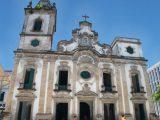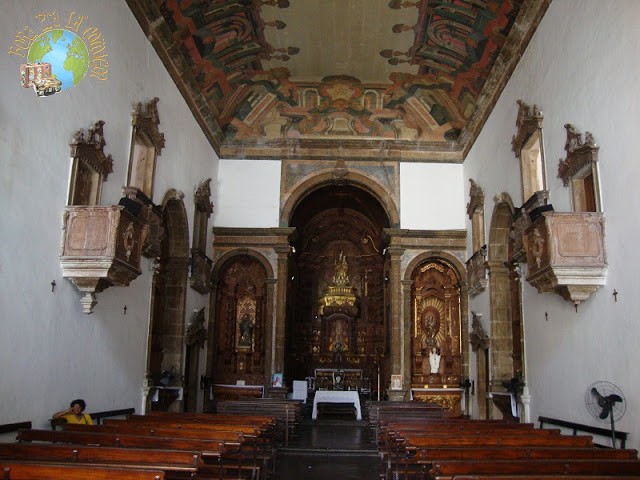Este post também está disponível em:
Português
English

The Church of Our Lady of the Rosary of Black Men in Recife is located on Larga do Rosário Street in the Santo Antônio neighbourhood, which is part of the Recife Sagrado was built in 1630 by the Brotherhood of the Rosary of Black Men, an association formed by black slaves.
It should be noted that the Africans who were transported as slaves to Brazil belonged to different tribes (or nations), such as those of Angola, Benguela, Cambinda, Mozambique, Congo, Cassanges, among others.
And each of them had their own languages (or dialects), customs (council of elders, festivals), and specific sacred and religious rituals (rites of Xangô, feasts of the dead and feasts of the magi).
In the Congo, in particular, blacks had certain privileges, being able to elect a king (in their native language, their Muchino riá Congo), and to reign over the people of the other nations of Africa, whether they were Creole or African, free or slaves.
In this sense, the first commitment of the Brotherhood of Nossa Senhora do Rosário dos Homens Pretos, authorising the crowning of a king of the Congo at its festivities, is recorded on 8 May 1711.
It was to survive the pain of slavery and exile (both from their homeland and from family and friends) that the slaves tried to unite in their new habitat, harmonising their ancestral rites as best they could.
Video “Igreja de Nossa Senhora do Rosário dos Homens Pretos”

Igreja de Nossa Senhora do Rosário dos Homens Pretos
In this way, religious associations represented an important link, through which black people could express their needs for defence and protection, their desires for freedom, charity towards their neighbours and human solidarity.
The festivities of the Brotherhood of Nossa Senhora do Rosário dos Homens Pretos were therefore made up of dances and drumming that were not part of the Catholic liturgy.
Thus, the rituals performed by these brothers were even banned by the Inquisition.
The quilombos in particular, both Palmares and the others between Cabo de Santo Agostinho and São Francisco river, were expressions of the associative spirit of Africans.
And this associative tendency, which came from the quilombos (which were located in rural areas), also extended to urban areas.
The Brotherhood retained the coronation system found in Africa, with maracatu rituals and processions, with archers at the head, two strings of bridesmaids, religious symbols, decorated dolls, alligators, cats, dignitaries and, finally, the king and queen of the Congo, followed by musicians.
On the first Sunday in October 1645, according to the records, Henrique Dias celebrated with his black brothers in the Igreja de Nossa Senhora do Rosário dos Homens Pretos, with all the pomp of their patron saint.
Also recorded in the Brotherhood’s books up to 1888 are all the coronations of the kings and queens of Angola, Congo and Cambinda.
It was through these coronations that the maracatu, one of the most beautiful and expressive manifestations of Northeastern folklore, originated.
The Brotherhood of Nossa Senhora do Rosário dos Homens Pretos (Our Lady of the Rosary of the Black Men), in colonial Brazil, despite the miserable condition of its members, spared no effort to build temples as rich as those erected by the nobility, either by providing free labour or by purchasing materials.
In this regard, there are the deeds drawn up by the various treasurers over the centuries. Sometimes the brothers paid their debts by making sweets.
One of the records, for example, states the following as payment: “to the players of the dances seven patacas and viola strings 640 and two pairs of shoes to the dancers, with an alms paid to the chaplain”.
In 1739, the façade of the church was in ruins. The Brotherhood then decided to build a new frontispiece.
Famous carvers such as Manuel Pais de Lima (who was in charge of the frontispiece) and Manuel Alvarez worked on the Church of the Black Men, as well as a number of carpenters and joiners who worked hard for a long time to restore the building.
The temple began to be rebuilt in 1750 and in 1777 the work was completed. Inspired by Franciscan convents, the church became an icon of Baroque art. In terms of style, therefore, the building is typical of those existing in the second half of the 18th century.
The building has a colonial style, but a number of its altars retain the rococo style.
The same can be said of its façade: simple and authentically 18th-century, it has a single tower, a high frontispiece with volutes and a rosary that takes the place of the traditional coats of arms of Pernambuco churches.
The church has five large doors on its façade. In the niche of one of them is a secular image of Our Lady of the Rosary from the time the church was founded, as well as an old image of Saint Benedict in the consistory dating from 1753.
The carvings on the high altar, the panel painted on its original lining (the image of the Virgin Mary, flanked by mulatto cherubs, handing the rosary to Saint Dominic, the inspiration for the Order) and the furniture in the sacristy are very well preserved. There is an art gallery in the side corridor.
The image of the patron saint, one of the most beautiful examples of Luso-Brazilian art, is noteworthy: it is life-size, made of polychrome wood, and features glass eyes and silver implements. Inside, the pilasters, architraves and arches are jaspered.
With the exception of Our Lady of the Rosary, Our Lady of Good Time and Saint Dominic, all the other images on the altars represent black saints. They are: St Benedict, St Balthazar, St Iphigenia and St Moses, St Anthony of Catalagirona and St Elesban.
The religious system of the Brotherhood changed after the advent of the Republic, and it began to receive people of any colour, with the right to vote and to be judged, as well as the right to modify religious festivals and the administrative system.
Thus, the Brotherhood of Black Men began to conform to the circumstances and canons in force in Catholic brotherhoods and religious orders.
At the beginning of the 20th century, an unpleasant incident occurred between the brotherhoods of São Benedito and the Third Order of São Francisco: when they settled in the convent of Santo Antônio in Recife, the black brothers began to notice the contempt of the brothers of the Third Order, as well as a series of unreasonable demands on the part of the latter – white, rich and prominent men.
On 29 September 1907, after a general assembly, as a result of this contempt, the black brothers of São Benedito decided to leave in procession, carrying the platform with the image of their patron saint – the venerated black saint – abandoned the Church of the Third Order, and asked for shelter in the temple of the brothers of Nossa Senhora do Rosário.
Tourism and Travel Guide to Recife, Pernambuco, Bahia and Salvador



















